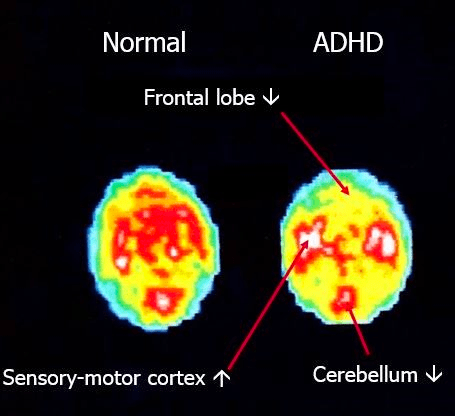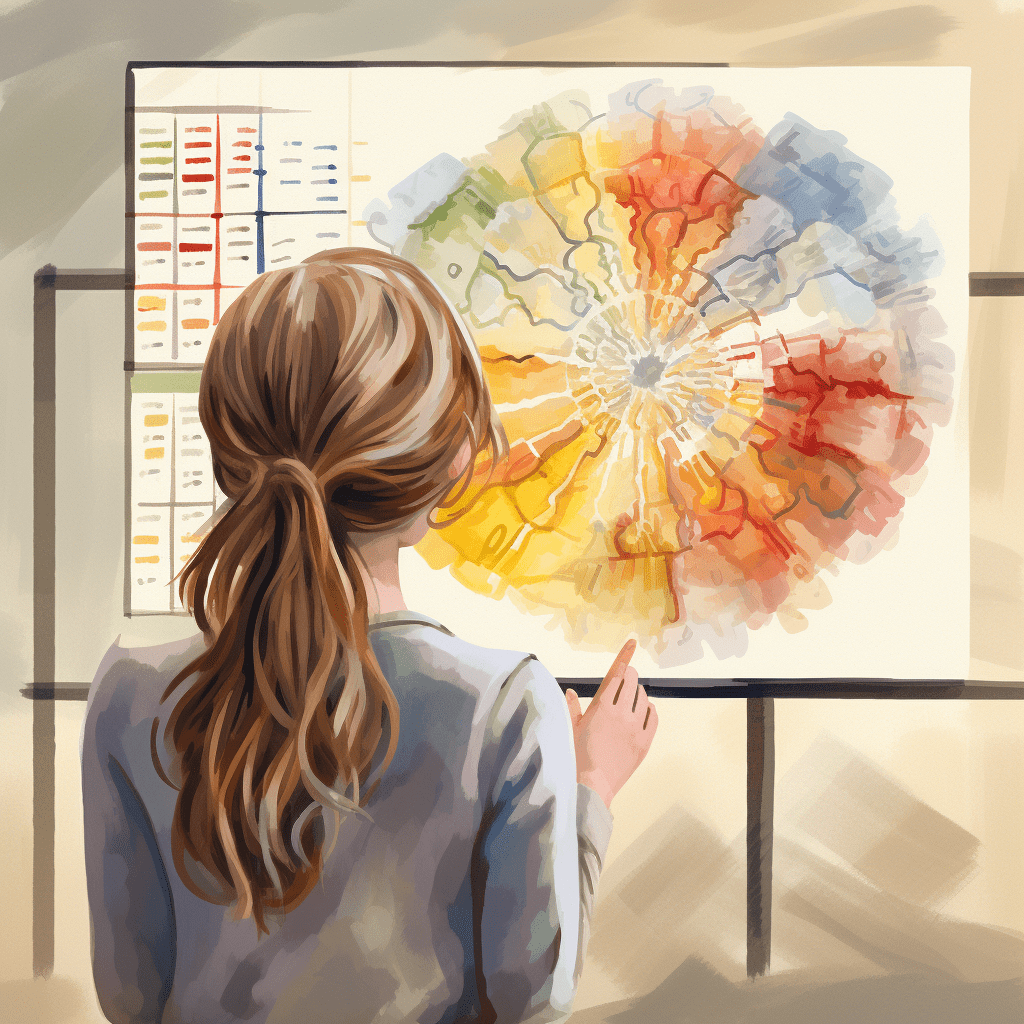Philosophy students, Middle Eastern doctors, and now neurophysiologists, but most of all, people, have found the brain to be a mystery. Even an ordinary, developed brain is rife with surprises. What, though, is going on in the brain of someone with ADHD? It is not the same as a "normal" brain, right?
Alright, buckle up because we're about to dive into the brainy showdown. I gonna shed some light on how an ADHD brain vs. a normal brain has its own unique wiring.
[“Normal” Brain vs ADHD brain ] “Normal” Brain vs ADHD brain
How Does Life Look for a Non-ADHD Brain?
Alright, picture yourself as a multitasking genius. “Normal brain” (or neurotypical, since there is nothing normal about all of us on the planet 😎) can keep your emotions in check, keep you focused, and keep your crazy out of the wilds. It is the sorcerer working behind the scenes to keep you going.
Imagine you're juggling school, work, and texting your bestie the latest gossip. A neurotypical brain won't have a problem handling all that. In addition, typical brainpower also keeps you from becoming a total hot potato on a math test or making an unnecessary online purchase.
In the midst of life's mayhem, it's cool to have a helpful organizing app in your head that helps you remember things, systematize them, and manage your mental state.
So, a typical brain maintains a sense of stability despite daily turmoil.
How Non-ADHD Brain Functions
The prefrontal cortex is a part of the brain that is well-developed in neurotypicals. It helps you plan, make decisions, and control impulses. This paves the way for controlled emotions and behavior, as well as effective information handling, like reading or while driving.
By now, you probably have a pretty good understanding of how the prefrontal cortex works. Now, here's a quick and simple intro to brain chemistry: In our brains, there is a system of messengers called neurotransmitters. The neurons can talk to each other. Neurons are small building blocks of the nervous system.
And there are these two main mood messengers: dopamine and noradrenaline. An average brain releases dopamine and norepinephrine in balanced amounts so they can focus, plan, organize, and complete tasks easily. Also, since the brain has both inhibitory and excitatory neurotransmitters, it can react to things in the right way.
Oh, that sounds kinda cool. So, where does it get wonky in ADHD-prone minds?
ADHD and Normal Brain: Diving Deeper
Brain: ADHD Addition
In a nutshell, brains with ADHD differ structurally and functionally compared to the typically developing ones. ADHD affects the frontal lobes, cortex, limbic system, and reticular activating system in our head, along with hormone imbalances. [1]
“What is causing this?”, you may ask. We don't really know what's causing it. For decades, neuroscientists have studied the structure and wiring of the brain to figure out why people with ADHD, and people who do not, have different brain functions.
Here's some stuff I came across while researching.

ADHD Brain Design Differences
Research suggests that pals with ADHD have a smaller prefrontal cortex and basal ganglia in their brains. “OMG, what the heck does that mean?” In simple terms, these parts are like the brain's hubs for making decisions and handling movement. This makes it a little harder for you to control your cravings and calm down when you feel hyperactive.
On top of that, the white matter in the brain, which is basically the information highway connecting different brain areas, is less developed in people with ADHD. This can mess with how the brain processes info and decides what to do with it. In short, your brains aren't as strong as Wi-Fi, so making decisions is a bit challenging.
Chemistry Differences in an ADHD Brain
Remember, that brain's got these cool messengers called dopamine and norepinephrine, and they are in charge of attention and focus? Now, in ADHD, these messengers get a bit too out of control, throwing off focus. It's like having a seesaw in your head, but instead of a smooth ride, it's a bit bumpy. The balance between "pay attention" and "stay chill" is tricky, making focus a challenge.
Besides that, another neurotransmitter rush causes some havoc (an imbalance of inhibitory and excitatory neurotransmitters). Often, this can make you a bit impulsive and turn your emotions into a rollercoaster because the brain is cranking up the excitement (dopamine).
Cognitive Differences of ADHD Brains
Attention deficit hyperactivity disorder causes differences in brain structure and chemical balance that can also make it hard to think and reason in many ways.

Hyperfocus and Restlessness
We already know that one of the hallmark symptoms of ADHD is difficulty with attention and focus. And it's not playing the rules, thus hyperfocusing.
Another small but important part of the brain is called RAS, and it is located way back in the skull. Basically, it works as a natural wake-up and sleep-timer, much like your body's internal clock. As well as that, it's the one who shouts out, "Focus, buddy!".
You might have trouble sleeping and lose focus in two seconds if it slows down, even if you are trying to focus on a very important task that you cannot mess up.
Impulsivity and Hyperactivity
Do you ever meet someone who is just bursting at the seams with enthusiasm, or perhaps you are that person—a "thinker on the go"? It could be a hyperactive-impulsive ADHDer.
People with ADHD think of impulsivity as their outgoing friend who always jumps at the chance to hang out. We act without thinking, which is a common trait of people with ADHD.
This is because the areas of the brain that regulate movement and executive functions—the prefrontal cortex and basal ganglia—are smaller in ADHDers. That is why you're more likely to act without a second thought and have trouble sitting still.
Emotional (Dys)regulation
Emotional dysregulation is a bothersome and common sign of ADHD that about 70% of adult ADHDers deal with every day. [2]
It's also because of an imbalance of already well-known neurotransmitters that either slow down or speed up activity. Anger flare-ups in people with emotional dysregulation do not build up gradually but rather all at once. And likewise, that's why you sometimes can't control your whims.
Or someone ensnared in ADHD paralysis, for instance, might swiftly go from feeling cheerful and carefree to melancholy and let down.
Difficulty with Decision-Making and Planning
No longer do the past, present, and future maintain separate pathways; rather, they blend into one another.? And it can be very difficult to formulate objectives for the distant future, right?
You may feel a bit of a time-blind; it's hard to plan and organize things and make hasty decisions. No, it is not that you do not care about doing things the right way; rather, it is just that our minds are wired to wander aimlessly.
ADHDers may find it hard to plan ahead and make decisions because their prefrontal cortex is smaller. Because it controls these processes, not fully developing this part of the brain can make it harder to plan, organize, and make quick decisions.
Does it ring a bell? An ADHD planner is one of the awe features in the Numo app. It is made by ADHDers to help you keep up with your tasks and commitments. Try it out and share your thoughts with us!
ADHD Brain Scan vs “Normal” Brain Scan
Okay, let's take a look at brain scans (they're colorful and fun).
In a brain with ADHD, the filters show a smaller prefrontal cortex and basal ganglia. These are the brain powerhouse areas for decision-making and movement control, and they're a bit smaller in the ADHD crew.


[Managing ADHD Brain Differences] Managing ADHD Brain Differences
Although a typical brain and an ADHD brain are structurally and functionally different, there are ways to compensate for these distinctions and boost mental performance.
Meds
For people with ADHD, medication is often recommended to help balance neurotransmitters and boost cognitive skills. Stimulant medication that raises brain levels of the feel-good chemicals dopamine and norepinephrine can help you concentrate better.
Therapy
Although, unfortunately, medicine is not everything. If there were a silver bullet, I would take it and be perfectly happy, but alas, the issues are more complex than that.
A specialist's advice is your best bet. You could say they are like detectives for the mind. Tell them everything on your mind, and do not hold back from sharing even the most random thoughts, feelings, or impulses.
One example is cognitive behavioral therapy (CBT), which can help you learn how to deal with impulsivity and emotional dysregulation. It can also help you get better at making choices and making plans.
Life Style Alterations
Managing ADHD without meds can also help you deal with the differences in the brain. Getting enough exercise, eating well, and getting enough sleep can all help your brain function and overall health.
For instance, some studies say that sports can help those parts of your brain that are linked to ADHD work better and make your symptoms go away. [3]
Numo Community for Support
Come join our squads and tribes thriving with like-minded mates, where you will never be called “not normal.” When people with ADHD get together in these groups, they share jokes, laughs, and tips on how to keep up with chores without getting stressed out. Plus, share real memes, of course.
[Conclusion] Final thoughts
To that end, you might ask, "Am I destined to be worse than normal people?" It does not mean you cannot accomplish remarkable things; in fact, it is quite the opposite. When it comes to day-to-day tasks and professional pursuits, many artistic ppl with ADHD actually thrive.
Further research into neurobiological factors gives us hope that we will one day be able to solve the problems caused by ADHD. Before that happens, people with ADHD can better handle their unique brain wiring with the help and strategies I mentioned above.
Go Beyond “Normality” with Numo ADHD app!
Numo, the cringe-free ADHD app, is what really changes things. It is an all-in-one resource for ADHD-related needs.
Put an end to the monotony of daily chaos with these smart organizing and planning tools
- You can quiet your racing thoughts with the help of a static noise generator
- Subscribe to receive quick reads every day that are jam-packed with ADHD relationship strategies and coping mechanisms
Dare to break free from the chains of physical limitations!
Sources
The Lancet Psychiatry. Subcortical brain volume differences in participants with attention deficit hyperactivity disorder in children and adults: a cross-sectional mega-analysis.
Impulsive Aggression as a Comorbidity of Attention-Deficit/Hyperactivity Disorder in Children and Adolescents
Mehren A, Reichert M, Coghill D, Müller HHO, Braun N, Philipsen A. Physical exercise in attention deficit hyperactivity disorder - evidence and implications for the treatment of borderline personality disorder.
.-min.png)










